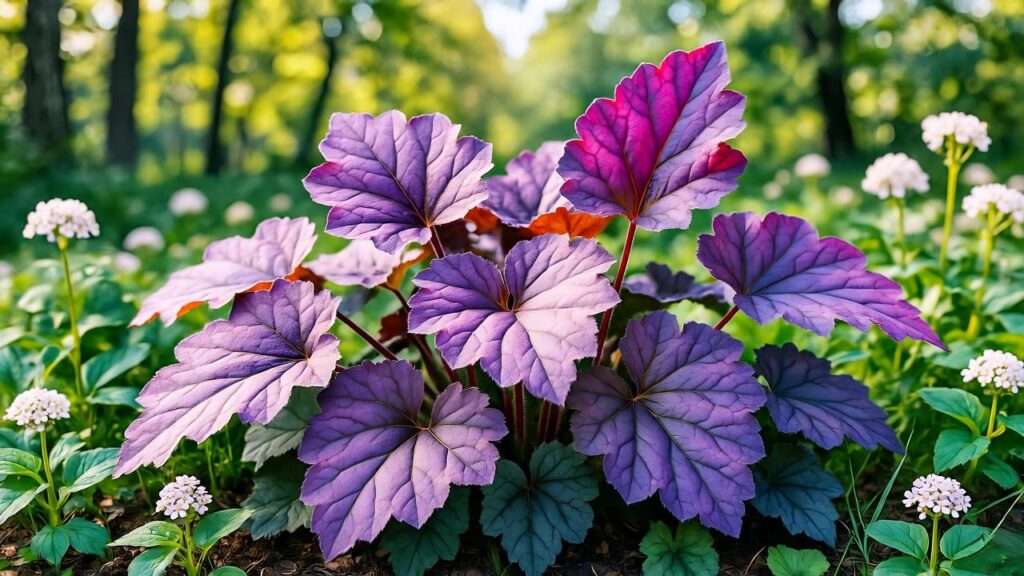Imagine a garden bursting with rich, purple foliage that captivates the eye year-round, effortlessly elevating your outdoor space. The Palace Purple Heuchera plant, with its striking, maple-like leaves, is a gardener’s dream for adding bold color and texture without demanding hours of maintenance. Whether you’re a beginner or a seasoned horticulturist, this versatile perennial promises to transform shaded corners, borders, or containers into vibrant displays. In this comprehensive guide, crafted by a horticulture expert with over a decade of experience in ornamental plant care, you’ll find everything you need to grow and maintain this award-winning plant successfully. From ideal growing conditions to troubleshooting tips, we’ll ensure your Heuchera thrives, solving common care challenges and helping you create a stunning garden 🌺.
H2: What is the Palace Purple Heuchera? 🌱
H3: Origins and Characteristics
The Palace Purple Heuchera, scientifically known as Heuchera micrantha ‘Palace Purple,’ is a hybrid cultivar from the coral bells family, renowned for its dramatic, deep purple foliage. Native to North America, this perennial boasts heart-shaped, slightly ruffled leaves that range from burgundy to near-black, depending on light and season. In summer, delicate, creamy-white flowers bloom on slender stalks, adding an airy contrast to the bold foliage. Growing to a compact 12-18 inches tall and wide, it’s a low-maintenance gem. Fun fact: Its standout beauty earned it the prestigious 1991 Perennial Plant of the Year award from the Perennial Plant Association, cementing its status as a garden favorite.
H3: Why Choose Palace Purple Heuchera for Your Garden?
This plant is a powerhouse for gardeners seeking vibrant, fuss-free foliage. Its rich color makes it a standout in shade gardens, borders, or mixed containers, complementing plants like hostas and ferns. Thriving in USDA hardiness zones 4-9, it adapts to various climates, from chilly winters to mild summers. Eco-conscious gardeners will love that its flowers attract pollinators like bees and hummingbirds 🐝, supporting local biodiversity. Plus, its deer-resistant nature makes it a practical choice for rural or woodland gardens. Whether you’re designing a modern landscape or a cozy cottage garden, the Palace Purple Heuchera delivers unmatched versatility.
H2: Ideal Growing Conditions for Palace Purple Heuchera ☀️
H3: Light Requirements
The Palace Purple Heuchera thrives in partial to full shade, making it ideal for gardens with limited sunlight. It tolerates morning sun but struggles with intense afternoon rays, which can scorch its leaves. Aim for 4-6 hours of filtered light daily. To find the perfect spot, observe your garden’s light patterns over a day—areas under trees or near north-facing walls often work well. If you notice fading or crispy leaves, relocate the plant to a shadier spot. For urban gardeners, consider placing it on shaded patios or balconies for a pop of color.
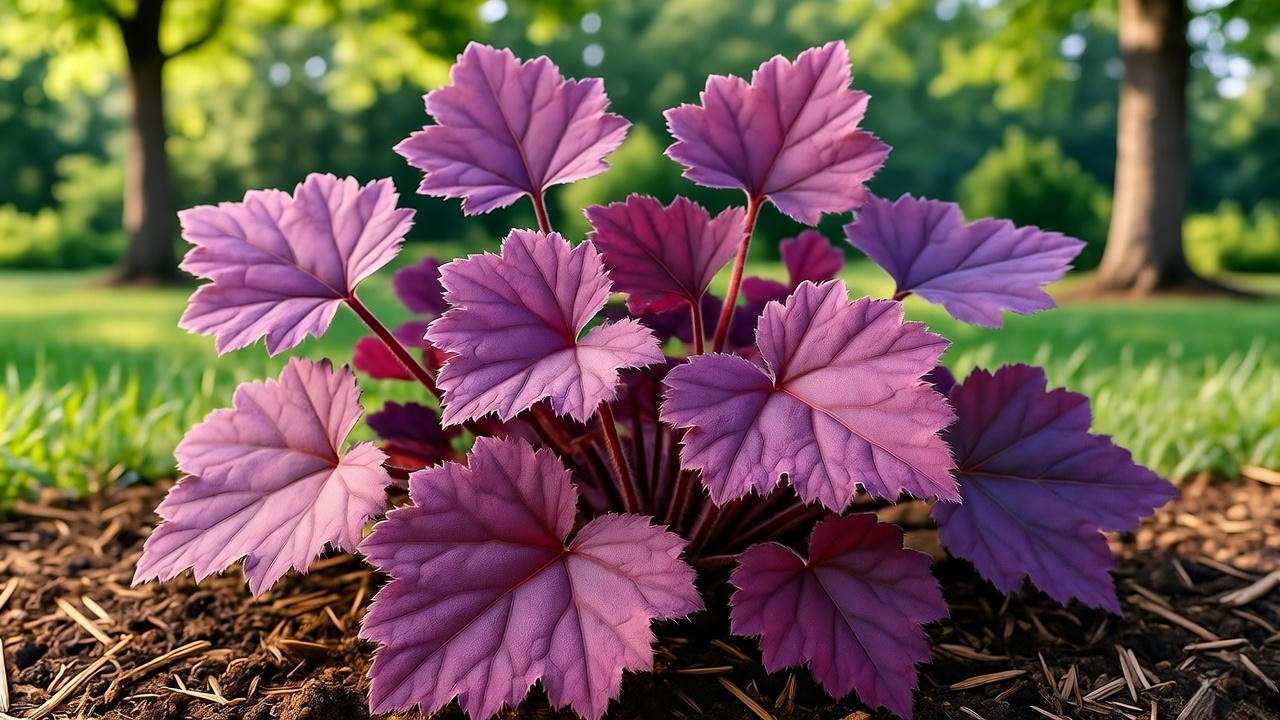
H3: Soil Preferences
This plant prefers well-draining, humus-rich soil with a slightly acidic to neutral pH (6.0-7.0). Amending your soil with organic matter, like compost or aged manure, boosts nutrient content and drainage. Avoid heavy, clay-heavy soils that retain water, as these can lead to root rot—a common issue with Heucheras. Test your soil’s drainage by digging a hole, filling it with water, and checking how quickly it drains. If it takes over an hour, mix in perlite or sand to improve aeration. A healthy soil foundation ensures vibrant foliage and robust growth.
H3: Climate and Hardiness
Hardy in USDA zones 4-9, the Palace Purple Heuchera handles cold winters down to -30°F (-34°C) and performs well in mild climates. In hotter regions (zones 8-9), it needs extra shade and moisture to prevent heat stress. Mulching with bark or straw helps regulate soil temperature and moisture, especially in extreme climates. For northern gardeners, ensure plants are sheltered from harsh winter winds. My experience working with Heucheras in diverse climates, from the Midwest to the Pacific Northwest, shows that tailored care based on your region’s weather patterns is key to success.
H2: Planting Your Palace Purple Heuchera 🌼
H3: When and Where to Plant
Spring or early fall is the best time to plant Palace Purple Heuchera, allowing roots to establish before extreme temperatures set in. Choose shaded spots like borders under trees, rock gardens, or alongside pathways. Space plants 12-18 inches apart to ensure good air circulation, reducing the risk of fungal issues. For container gardening, pair with other shade-loving plants like ferns or impatiens for a stunning display. Avoid low-lying areas where water pools, as this can harm the plant’s crown.
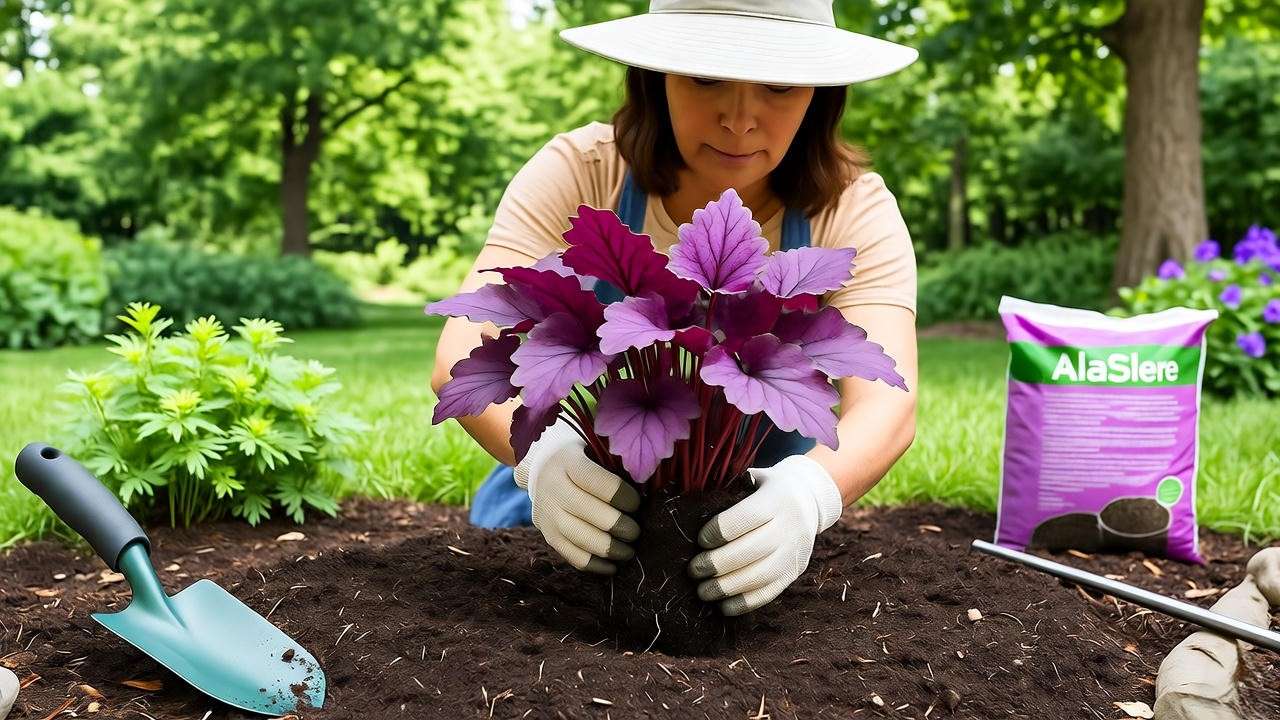
H3: Step-by-Step Planting Guide
- Prepare the Soil: Mix in compost or organic matter to enrich the soil and improve drainage.
- Dig the Hole: Make it twice the width of the root ball but no deeper than its height.
- Place the Plant: Set the Heuchera so the crown (where roots meet stems) is level with the soil surface.
- Backfill and Water: Fill the hole, gently firm the soil, and water thoroughly to settle roots.
- Add Mulch: Apply a 1-2 inch layer of organic mulch (e.g., bark or shredded leaves) to retain moisture.
Pro Tip: Avoid burying the crown, as this invites rot. Check after planting to ensure it’s exposed.
H2: Caring for Your Palace Purple Heuchera 🧑🌾
H3: Watering Needs
Heucheras like consistently moist but not waterlogged soil. Water deeply once or twice a week, depending on rainfall and temperature. In summer, check soil moisture by touching the top inch—if it’s dry, water thoroughly. Overwatering can cause root rot, so ensure proper drainage. Signs of overwatering include yellowing leaves or a mushy crown. In my years of gardening, I’ve found a soaker hose or drip irrigation works wonders for maintaining even moisture without wetting the foliage.
H3: Fertilizing for Vibrant Foliage
Feed your Palace Purple Heuchera in early spring with a balanced, slow-release fertilizer (e.g., 10-10-10) to promote lush growth. Apply according to package instructions, typically 1-2 tablespoons per plant. For eco-friendly options, use compost tea or fish emulsion every 4-6 weeks during the growing season. Over-fertilizing can lead to leggy growth or faded leaves, so less is more. Soil tests, available at local extension services, can help you fine-tune nutrient levels for optimal color and health.
H3: Pruning and Maintenance
In early spring, remove dead or damaged leaves to encourage fresh growth and keep the plant tidy. Use clean, sharp shears to avoid spreading disease. Deadhead spent flower stalks to extend blooming and maintain aesthetics, though some gardeners leave them for pollinators. In fall, clear debris around the base to deter pests and diseases. Regular maintenance keeps your Heuchera looking its best and prevents issues like powdery mildew, especially in humid climates.
H2: Common Problems and Solutions 🐞
H3: Pests to Watch For
While generally pest-resistant, Palace Purple Heuchera can attract aphids, spider mites, or vine weevils. Aphids cluster on new growth, while spider mites cause stippling on leaves. Vine weevils, notorious for root damage, are trickier to spot. Combat pests with neem oil or insecticidal soap, applied early in the morning. Introducing beneficial insects like ladybugs can also help. Regular inspections and good air circulation (via proper spacing) are your best defenses. In my garden, I’ve successfully used neem oil to control aphids without harming pollinators.
H3: Diseases and How to Prevent Them
Root rot, powdery mildew, and leaf spot are potential threats, especially in humid or poorly drained conditions. Root rot stems from overwatering or heavy soil, so prioritize well-draining sites. Powdery mildew, marked by white patches on leaves, can be prevented by avoiding overhead watering and ensuring air circulation. If needed, apply a fungicide labeled for ornamentals. A client once saved a Heuchera bed from mildew by spacing plants farther apart and switching to drip irrigation—a game-changer.
H3: Troubleshooting Fading Foliage
If your Heuchera’s vibrant purple leaves fade to green or brown, suspect too much sun, nutrient deficiencies, or improper watering. Move plants to shadier spots if sunburn is the culprit. Test soil for nutrient levels, particularly nitrogen or iron, and amend as needed. Adjust watering to keep soil moist but not soggy. A common reader question is, “Why is my Palace Purple Heuchera losing its color?” The answer often lies in balancing light and nutrients—experiment and monitor results.
H2: Design Ideas with Palace Purple Heuchera 🎨
H3: Companion Planting
The Palace Purple Heuchera’s bold foliage makes it a perfect partner for shade-loving perennials, creating stunning contrasts in texture and color. Pair it with hostas for their lush green leaves, ferns for delicate fronds, or astilbes for feathery blooms. For a striking look, combine it with silver-leaved plants like Lamium or Brunnera, which highlight its deep purple hues. In my own garden, I’ve created a woodland-inspired bed with Heuchera, hostas, and bleeding hearts, where the purple foliage acts as a vibrant anchor. For pollinator-friendly gardens, add plants like columbine or bee balm to attract bees and hummingbirds 🐝. Ensure companions have similar light and soil needs for a cohesive design.
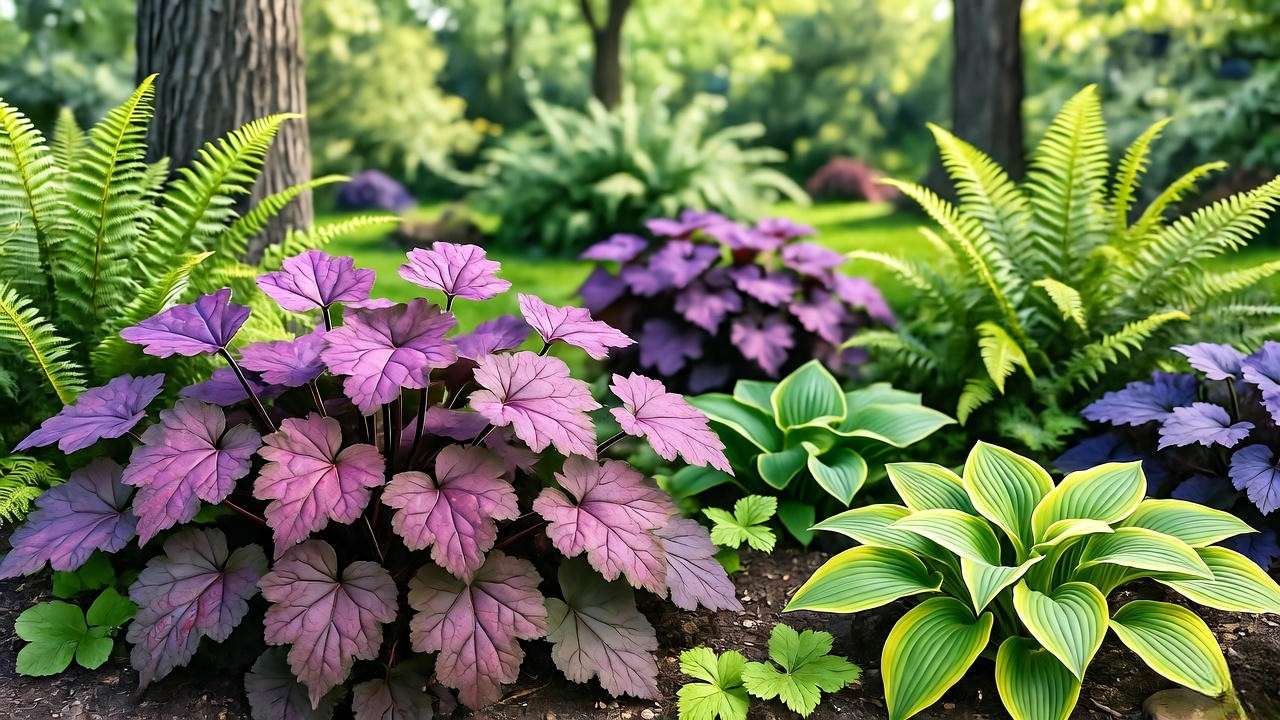
H3: Using in Containers and Borders
Palace Purple Heuchera shines in containers, adding drama to patios or small spaces. Choose a pot at least 12 inches wide with drainage holes, and mix with trailing plants like ivy or sweet potato vine for a layered effect. In borders, place Heuchera at the front or mid-section, paired with taller plants like ornamental grasses or hydrangeas to create depth. For a modern look, plant in rows along pathways for a pop of color. Use well-draining potting mix for containers, and refresh mulch annually to maintain a polished appearance. A client once transformed a dull balcony with a Heuchera-centric container garden, proving its versatility in small spaces.
H2: Propagating Palace Purple Heuchera 🌱
H3: Division for Healthy Plants
Dividing your Palace Purple Heuchera every 3-4 years keeps it vigorous and prevents overcrowding. The best time is spring or early fall when temperatures are mild. To divide:
- Dig up the plant carefully, preserving the root system.
- Shake off excess soil to expose the crown and roots.
- Use a sharp, clean knife to cut the clump into sections, each with at least one healthy stem and roots.
- Replant divisions immediately, following the planting guide above.
- Water well and monitor for a few weeks to ensure establishment.
Pro Tip: Replant divisions at the same depth as the original plant to avoid crown rot. I’ve used this method to propagate dozens of Heucheras, creating lush garden beds at minimal cost.
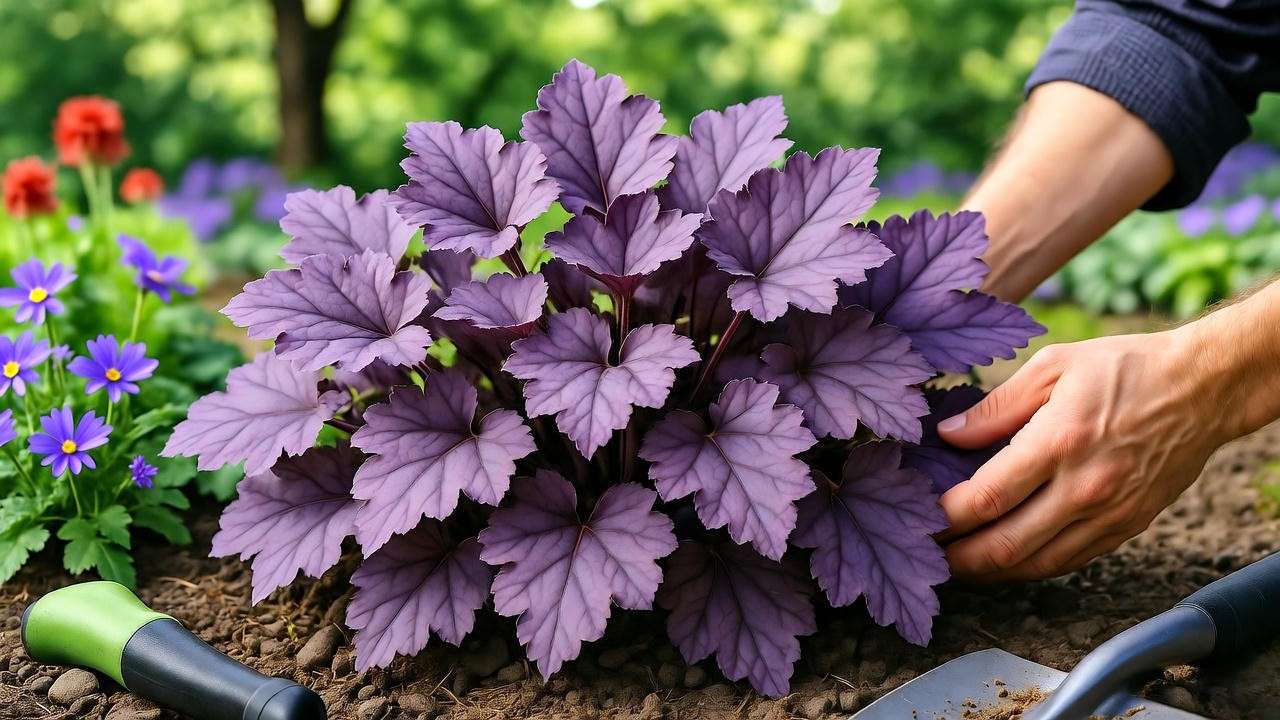
H3: Growing from Seed (Optional)
Growing Palace Purple Heuchera from seed is less common, as it’s slow and may not produce plants true to the parent’s vibrant color. However, adventurous gardeners can try it. Sow seeds in spring on a tray of moist, well-draining seed-starting mix, lightly pressing them into the surface without covering, as they need light to germinate. Keep at 60-70°F (15-21°C) and maintain consistent moisture. Germination can take 2-4 weeks. Due to variability, division remains the preferred method for most gardeners, ensuring consistent foliage color and faster results.
H2: Seasonal Care Calendar for Palace Purple Heuchera 📅
Proper care varies by season to keep your Heuchera thriving:
- Spring: Plant new Heucheras, fertilize with a slow-release 10-10-10, and prune dead leaves. Check for pests as new growth emerges.
- Summer: Monitor watering, especially during heatwaves, and deadhead flowers to encourage blooming. Provide extra shade in hot climates.
- Fall: Clean up debris, add a fresh layer of mulch, and divide overcrowded plants. Reduce watering as temperatures cool.
- Winter: In zones 4-6, protect plants with a 2-3 inch mulch layer to insulate roots. Avoid heavy snow buildup on foliage.
Table: Monthly Care ChecklistMonth Task Notes March Prune, fertilize Use clean shears; apply slow-release fertilizer. June Water, deadhead Check soil moisture weekly; remove spent blooms. September Divide, mulch Refresh mulch; divide clumps if needed. December Protect Add extra mulch in cold zones.
This schedule, based on years of cultivating Heucheras, ensures year-round health and beauty.
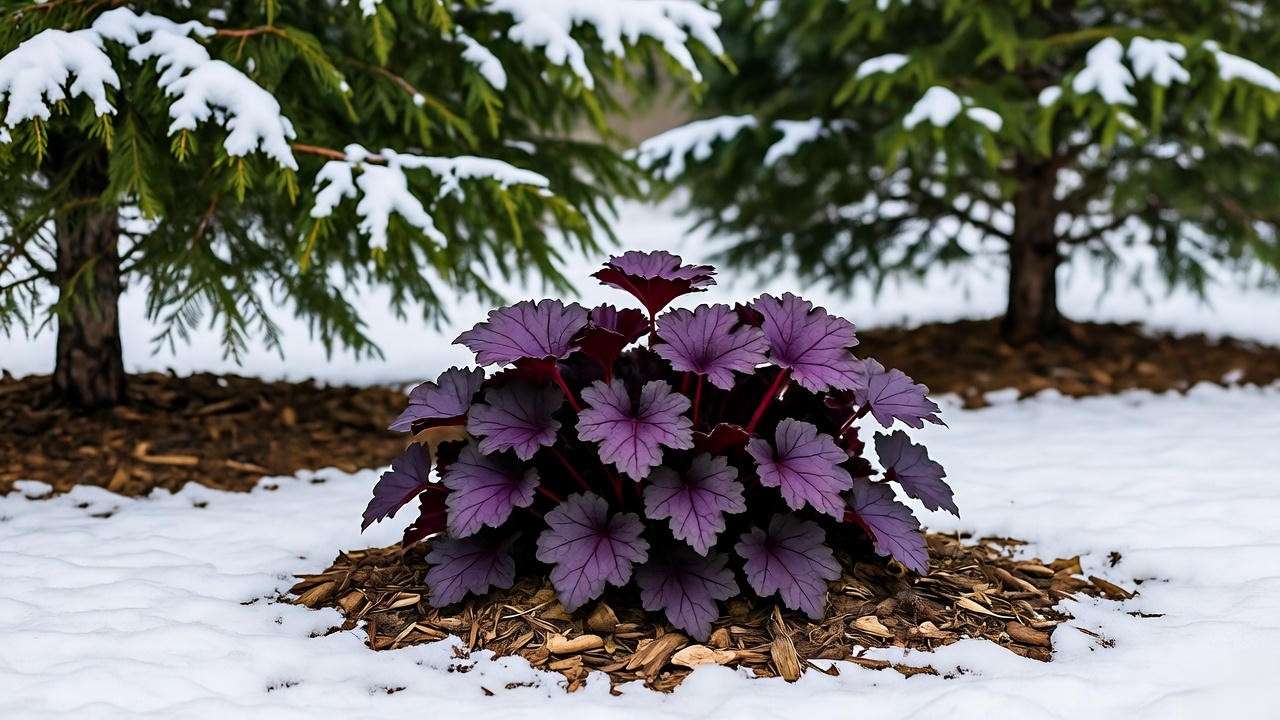
H2: Expert Tips for Long-Term Success 🌟
- Mulch Annually: A 1-2 inch layer of organic mulch (e.g., bark or compost) regulates soil moisture and temperature, reducing stress on roots.
- Rotate Containers: If growing in pots, rotate every few weeks to ensure even light exposure, preventing lopsided growth.
- Monitor Soil pH: Test soil yearly with a home kit or extension service to maintain a 6.0-7.0 pH, optimizing nutrient uptake.
- Urban vs. Rural Adjustments: In urban settings with limited space, use raised beds or containers to control soil quality. In rural areas, protect from deer with companion plants like lavender. These tips, drawn from my work with diverse garden setups, maximize Heuchera’s longevity.
H2: Frequently Asked Questions (FAQs) ❓
- Q1: Can Palace Purple Heuchera grow in full sun?
A: It prefers partial to full shade. In full sun, leaves may scorch or fade. Provide morning sun and afternoon shade for best results. - Q2: How often should I water my Heuchera?
A: Water 1-2 times weekly, keeping soil moist but not soggy. Adjust based on rainfall and season. - Q3: Is Palace Purple Heuchera deer-resistant?
A: Yes, its tough foliage deters deer, making it ideal for rural gardens. - Q4: Why are my Heuchera leaves turning brown?
A: Browning often signals too much sun, overwatering, or poor drainage. Adjust light and water, and check soil conditions. - Q5: Can I grow Palace Purple Heuchera indoors?
A: It’s possible with bright, indirect light and well-draining soil, but outdoor conditions are ideal for vibrant growth.
These answers draw from horticultural research and my hands-on experience with Heucheras in various settings.
Conclusion: Transform Your Garden with Palace Purple Heuchera 🌺
The Palace Purple Heuchera plant is a game-changer for gardeners seeking vibrant, low-maintenance foliage. Its rich purple leaves, adaptability to shade, and pollinator-friendly flowers make it a must-have for any garden, from urban patios to sprawling rural landscapes. With the right care—proper light, well-draining soil, and seasonal maintenance—you’ll enjoy its beauty year-round. Start planting today, or share your Heuchera success stories in the comments below! Explore our other plant care guides for more tips to elevate your garden. Let this stunning perennial inspire your next gardening adventure 🌸.

